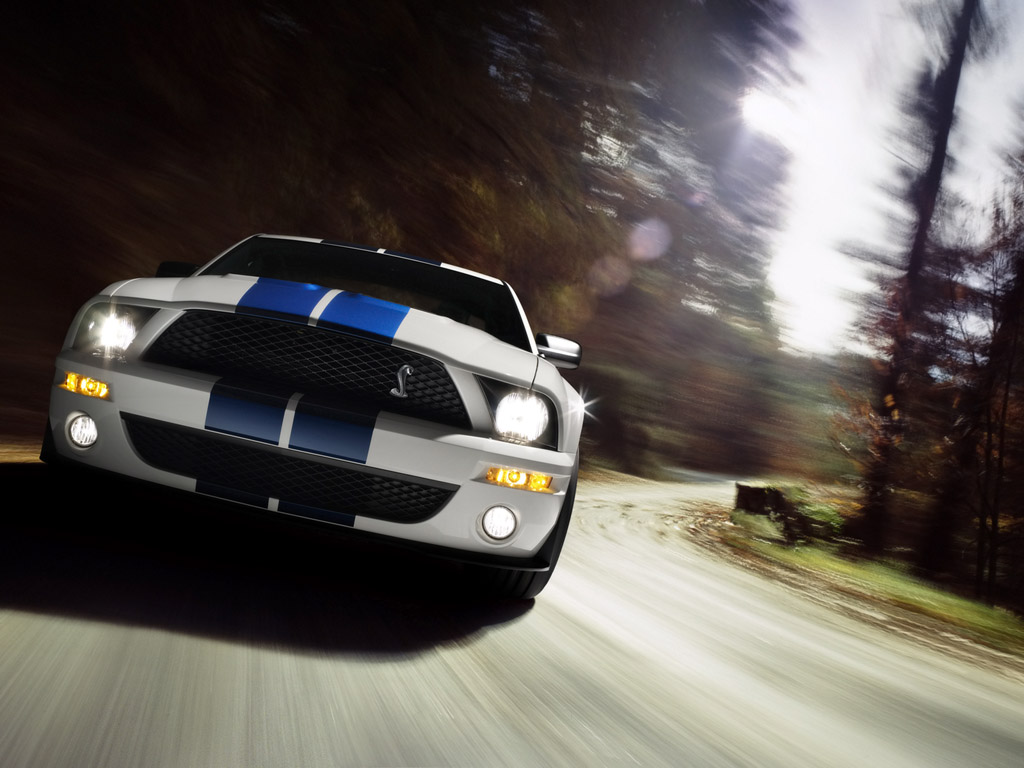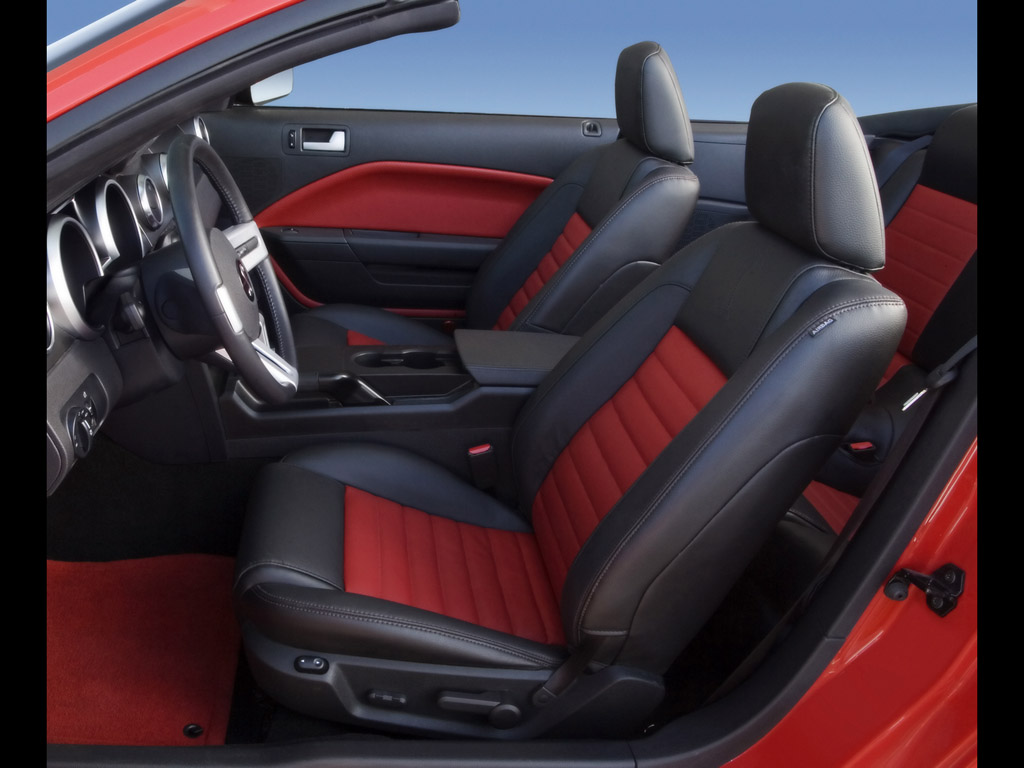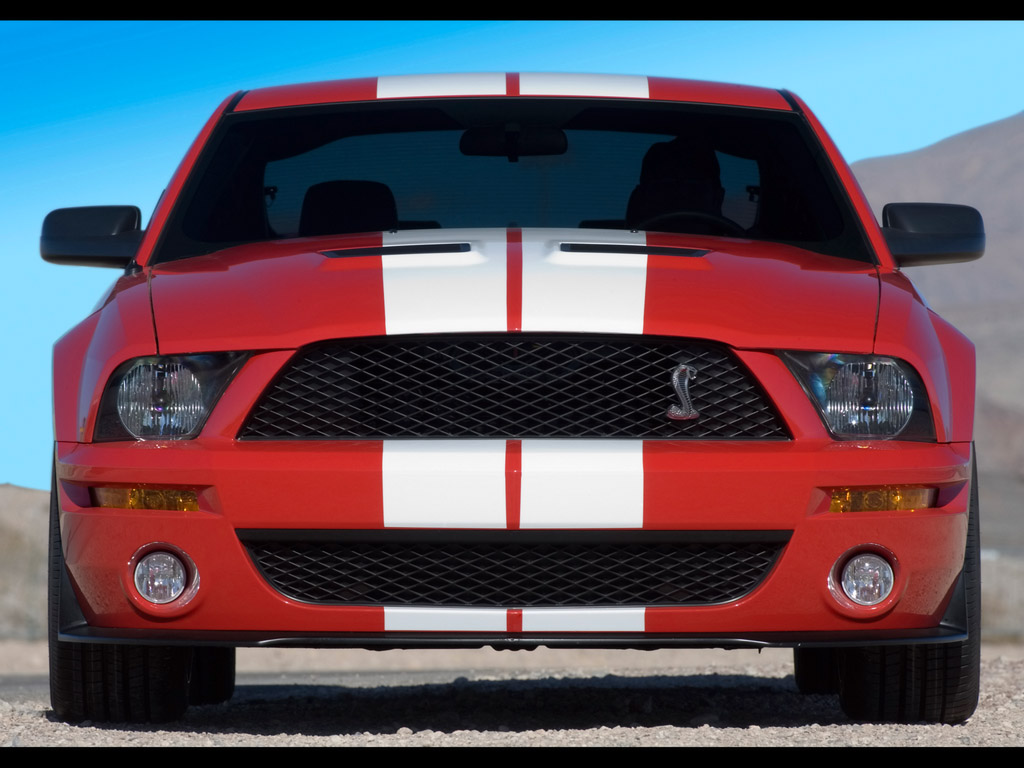2007 Ford Shelby GT500 Production
|
Price |
-- |
Production |
-- | ||
|
Engine |
5.4 liter V8 |
Weight |
3920 lbs (coupe) | ||
|
Aspiration |
supercharger & intercooler |
Torque |
475 lb-ft | ||
|
HP |
475 hp |
HP/Weight |
8.3 lbs per hp | ||
|
HP/Liter |
88 hp per liter |
1/4 mile |
-- | ||
|
0-62 mph |
-- |
Top Speed |
-- |
(from Ford
Press Release) What happens when a
legend from Texas reunites with a legend from Dearborn? The most
powerful Mustang ever.
After 40 years, racing legend Carroll Shelby and the Ford Mustang
are back together with the introduction of the 2007 Ford Shelby
GT500.
The collaboration between Shelby and Ford's Special Vehicle Team (SVT)
is yielding an instant collector's Mustang that builds 475
horsepower in its 5.4-liter supercharged V-8.
A modern interpretation of the Shelby Mustang of the 1960s, the Ford
Shelby GT500 uses advanced engineering to attain the performance
that made the original GT500 the king of the road.
True to the original GT500, it will be available both as a coupe and
as a convertible when it goes on sale in the summer of 2006.
"When Carroll was developing the original GT350 and GT500, he wanted
to build the most powerful, most capable Mustangs of his day," says
Hau Thai-Tang, director, Advanced Product Creation and Special
Vehicle Team. "Our goal was to build the most powerful, most capable
Mustang ever."
Serving as touchstone and inspirational leader for both the concept
and the production versions, Shelby was impressed by what the team
has accomplished.
"It's one thing to put 450 horsepower in an exotic supercar," says
Shelby. "It's another to put that much power in something as
affordable as a Mustang. The fact that they not only met their goal
but pushed on to 475 horsepower is a remarkable achievement."
Shelby knows something about creating modern supercars. He served as
a senior adviser on the team that developed and built the
550-horsepower Ford GT.
Power Play
As expected of anything
with Shelby's name on it, the heart of the car is what's under the
hood. The Ford Shelby GT500's supercharged 5.4-liter, 32-valve V-8
evolves from Ford's experience with tuning its modular, or MOD,
engines. Output is a brawny 475 horsepower.
The engine is force-fed an air-and-fuel mixture via a "Roots-type"
supercharger providing 8.5 pounds per square inch of boost. The
GT500 uses a cast-iron engine block. It borrows from the Ford GT
program aluminum, four-valve cylinder heads, piston rings and
bearings, adding a high level of performance durability to the
drivetrain. "Powered by SVT" camshaft covers add the finishing touch
to the engine.
Helping put the power to the pavement is a 6-speed manual gearbox.
For the performance driver, its evenly spaced gears mean less
"stirring" is needed to find the "sweet spot." This gives a
rewarding experience throughout the engine's broad torque curve. The
heavy-duty transmission has proven itself a willing companion to
Mustangs in both road and track environments, including recent
road-going Mustang Cobras and the new race-winning Mustang FR500C.
Power Requires Control
The Ford Shelby GT500
continues a legacy of all-around performance that made the original
a world-class racer on tracks and road courses around the world.
The Ford Shelby GT500 starts with the solid Mustang underpinnings.
The all-new Mustang was designed from the beginning with performance
derivatives in mind, providing an exceptionally rigid,
well-engineered starting point for GT500 chassis engineers.
SVT engineers retuned and upgraded key chassis components.
Improvements such as revised shocks, spring rates and upgraded
stabilizer bars help the Ford Shelby GT500 stop and turn with the
same authority as it goes.
The Ford Shelby GT500 features a MacPherson strut independent front
suspension with Reverse L lower control arms, and a solid-axle,
three-link rear suspension with coil springs and a Panhard rod for
precise control of the rear axle.
This rear suspension design has been validated on the track by Ford
Racing. The Ford Racing Mustang FR500C was purpose-built from the
base 2005 Mustang body structure and suspension geometry to run in
the Grand-Am Cup series, a class of road racing for production-based
cars.
Competing against the best from Germany and Japan, a Mustang FR500C
won its first race in the season opener at Daytona International
Speedway in February 2005. It went on to dominate the season and
clinch the championship.
"SVT and Ford Racing will be working closer than ever as we go
forward on future projects, especially Mustangs," says Thai-Tang, a
Ford Racing alumnus who served as the race engineer for the
Newman-Haas Racing team in 1993.
To match this power and handling ability, engineers fitted some of
the biggest brakes in the business to the Ford Shelby GT500.
Four-piston Brembo calipers are fitted to 14-inch Brembo vented
rotors up front, and 11.8-inch vented discs in the rear continue
SVT's legacy of great-braking Mustangs. Secure footing is provided
by 255/45ZR high-performance tires in front and 285/40ZR
high-performance tires in back. Wheels are 18 inches by 9.5 inches.
The Snake is Back
One glance shows this is
not the typical Mustang Cobra. A sinister-looking front-end design
includes wide upper and lower fascia openings with a functional air
splitter. The upper intake sports the famous Cobra logo floating
off-center in place of a centered galloping pony found on other
Mustangs. On either side, slanting headlamp openings add to the
dramatic front appearance.
The bulging hood has heat extractors protruding near the leading
edge, combining to provide improved airflow and aerodynamics. As air
passes over the hood, hot air from the engine compartment is drawn
out through ducts attached to the hood extractors.
"The restrained, performance-oriented SVT design theme has become
instantly recognizable to enthusiasts without brash styling cues,"
says Doug Gaffka, design director, Ford SVT vehicles. "The GT500
takes a huge leap forward by combining the modern Mustang muscle car
with the classic Shelby performance look."
The 2005 Mustang design team drew inspiration from classic 1968
Mustangs, the models that transformed the mild-mannered pony car
into a muscle car with attitude. Envisioning a high-performance
model, the team tested GT500 design cues on the Mustang GT coupe
concept that was unveiled at the 2003 North American International
Auto Show.
In 2004, designers further developed the GT500 look on the Mustang
GT-R, a race-bred concept with the dual purpose of foreshadowing
SVT's Mustang design direction and Ford Racing's plans to return
Mustang to road racing. The Ford Shelby GT500 Cobra concept coupe
capped the design conceptualization effort.
The production Ford Shelby GT500 Coupe now comes into full light,
punctuated by the classic Le Mans-style white stripes that race
along the top from nose to tail. The stripes recall the Shelby
Mustangs that marked another important 1960s Mustang transition when
Ford put it on the track to becoming a racing legend. The GT500
nomenclature is prominent in the lower bodyside racing stripe,
another cue from the classic Shelby Mustangs.
In a touch also borrowed from the GT500's past, no Le Mans stripes
will be seen on the 2007 Ford Shelby GT500 Convertible. However, the
convertible will sport a cloth top similar to those found on pricier
convertibles.
"There were no Le Mans stripes on Shelby's original GT500
Convertible, so we decided to pay homage by not offering them on the
2007 Ford Shelby GT500," says Gaffka. "We also went with a cloth top
material as another measure of substance and authenticity. The
fabric used is the same used on the 2002-03 SVT Mustang Cobra, the
Thunderbird, Jaguar and Ford's other high-end convertibles."
The unique rear fascia features lower strakes inspired by the Ford
GT's integrated rear airflow diffuser, and a rear spoiler
reminiscent of a classic GT500. To mark the collaboration of two
Mustang performance icons, the GT500 features Shelby and SVT badging.
The fenders each feature an updated design of the Cobra. The front
grille features an off-center snake in place of the standard running
horse. "GT500" is emblazoned inside the side rocker stripes, and the
name SHELBY is prominently written across the rear deck. The SVT
logo can be seen on the wheel center caps, a signature SVT location,
as well as on the doorsill plates. To top it off, the medallion
between the taillights reads "Shelby GT500" centered on the Cobra
image.
Cockpit Upgrades
Inside, too, upgraded
levels of flair and function abound. The locations of the
speedometer and the tachometer are swapped to provide
performance-oriented drivers with a better view of shift points
while changing gears. Front seats have received additional lateral
support to help keep the driver optimally positioned during
cornering. The interior is offered in a choice of two colors,
Charcoal Black or Charcoal Black and Crimson Red. The charcoal/red
offering features Crimson Red seating surfaces and door panel
inserts. Seating surfaces are leather with both interior treatments.
Snake logos embossed in the seat backs finish the package.
The Shelby GT500 script and Cobra image are repeated on the steering
wheel cap. Behind the wheel, the gauges wear light faces in keeping
with SVT tradition. The chromed accessories inside the cabin have
been replaced with a satin aluminum finish, including the aluminum
shift lever knob that is nicely positioned for quick, positive
shifts.
SVT and Shelby: The Legends Grow
With the look and legend
one would expect from Shelby and the kind of power and performance
enthusiasts have come to expect from SVT, the GT500 points to a
brand-new era in Ford's performance future.
Shelby first put his name on a Mustang back in 1964 when he was
asked to inject some high performance into the brand-new pony car.
The result was the GT-350R, a lightweight, handling-focused race car
that earned Mustang its first performance credentials. Subsequent
Shelby Mustangs included a street version of the race car, the
GT-350, and what was known as the "rent-a-racer" Mustang, the
GT-350H, a joint project with the Hertz rental car corporation.
The ultimate Shelby Mustang of the era was the GT-500KR, or "King of
the Road." Powered by a big block 428-cubic-inch "Cobra Jet" V-8,
the GT-500 was one of the most powerful, and memorable, muscle cars
of that period. Shelby Mustang production ceased in 1970 with a
total volume of 14,559 units.
The Ford Special Vehicle Team brought high performance back to
Mustang in 1993. After 12 years, with nearly 80,000 high-performance
Mustangs on the streets and total SVT vehicle production nearing
145,000, SVT is primed for growth with the GT500 serving as the
foundation for other performance Mustang projects.
By bringing together Shelby and Ford SVT, the company's commitment
to performance becomes as powerful as at any time in its history –
including the famed "Total Performance" days of the 1960s. From the
Ford GT supercar, the GT500, to a rejuvenated Ford Racing
Performance Parts program, performance and racing can drive
innovation and add luster to Ford's proud brand heritage.
"SVT will remain the leader in performance vehicle engineering,"
says Thai-Tang. "It will continue to build new, innovative products
using advanced processes that will not only provide great enjoyment
to the dedicated driving enthusiast, but that also will provide
great benefit to other Ford products and Ford Motor Company itself."
The Ford Shelby GT500 will be built at the Ford-Mazda joint venture,
AutoAlliance International, in Flat Rock, Mich.



